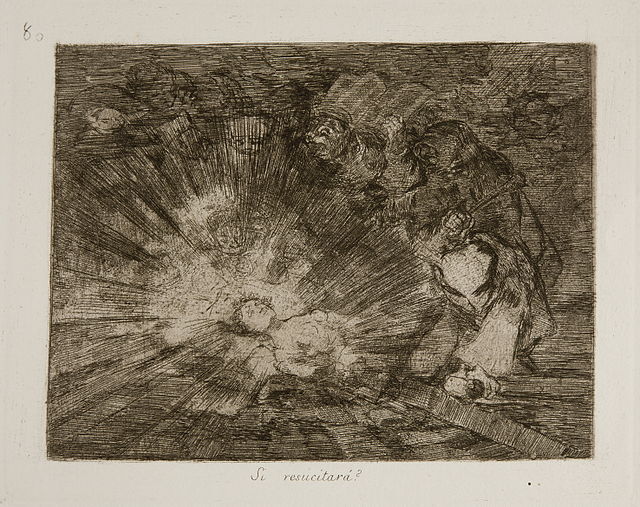-
Picture Rights
-
Courtesy of Wikimedia Commons
-
Print Title
-
Si Resucitara?
-
Accession Number
-
1949.12.80
-
Artist
-
Goya Lucientes, Francisco Jose de, 1746-1828
-
Date Created
-
1863
-
Edition
-
1st
-
Print/Plate Number
-
80
-
Description
-
The print Si Rescuitara? is plate 80 in Goya 's Los Desastres de la Guerra print series. Si Rescuitara? shows a dark scene both in terms of tone and theme. The central figure of this print is a woman in a white dress laying on the ground. The woman is wreathed in a strong, bright light. That light radiates barely onto a crowd gathered around the woman. The woman has a calm, serene look on her face. Directly to the right of her, a sinister group of figures is gathered. To the far right, a man in a white robe, brandishing a club. To his left, a man in a dark robe brandishes a gun at the woman. To his immediate left, a strange figure wields a book above his head. This man appears to have the head of a dog or a walrus. His figure follows a strong tradition of strange creatures by Goya. Many of Goya’s prints show a variety of strange, horrifying, and fantastical creatures. In addition to this figure, a group of strange creatures hover in the far right background. These figures are mostly obscured by the dark lines of the print. This print does not employ the technique of aquatint to create the tones of the print. To the left of the walrus-headed figures, a second crowd of figures is gathered. The crowd of figures is standing in a position indicating mourning. They have their heads turned down, and their mouths look to be gagged. This group of people are standing as a solemn crowd, not intervening or acting on anything they are seeing. In addition, the name “Goya” is signed in intaglio, while being upside down and reversed. In this edition, the mark is barely visible, and close inspection is needed to see it. The plate belongs to the “caprichos” section of Desastres. This includes allegorical plates, which Si Resucitara? definitely belongs to. The plate could take on any amount of meanings, but a possible interpretation could be one of freedom. The woman could represent freedom, being stifled by any number of groups, including the Church, or the military, either French or Spanish. This print shows a reality of grappling with Goya’s works. Many of Goya’s works, whether they be prints or paintings, can take on multiple meanings and interpretations. Goya was not one to give detailed reasoning or artists statements for his prints, so many of them remain somewhat of a transfixing mystery.
-
Edition Provenance
-
The print was originally acquired by the Cincinnati Art Museum in 1949, as a gift of the donor Emily Poole. The prints were originally owned by Alan C. Poole, the brother of Emily Poole, and the prints were donated as Emily was in charge of Alan’s estate. The prints originally came bound in a book, and were unbound from the book in 1960, by workers at the Cincinnati Art Museum. The prints are known to be first edition, which were printed in the workshop of Laurenciano Potenciano for the Real Academia in Madrid and completed in March 1863. The gap between when the print was printed, and when it was obtained by Alan Poole is unknown, and is unlikely to be resolved, as those knowledgeable with the estate of Alan Poole have passed away.
-
Condition
-
For shorthand, the print will be split into 9 sections, going from Top (T), Center (C) , Bottom (B), and Left (L), center (C) , Right (R) . The plate mark is very apparent on the print. The entire left edge of the print has evidence of binding, with the print being bound into a book of the series originally.
-
Holding Institution
-
Cincinnati Art Museum
-
Owned By
-
Cincinnati Art Museum (Cincinnati, Ohio; United States). (1949 - Present).
-
Alan C. Poole, donated by Emily Poole. (Cincinnati, Ohio; United States). (Unknown - 1949).
-
Workshop of Laurenciano Potenciano (Real Academia, Madrid; Spain). (1863 - Unknown).
 Si Resucitara?
Si Resucitara?